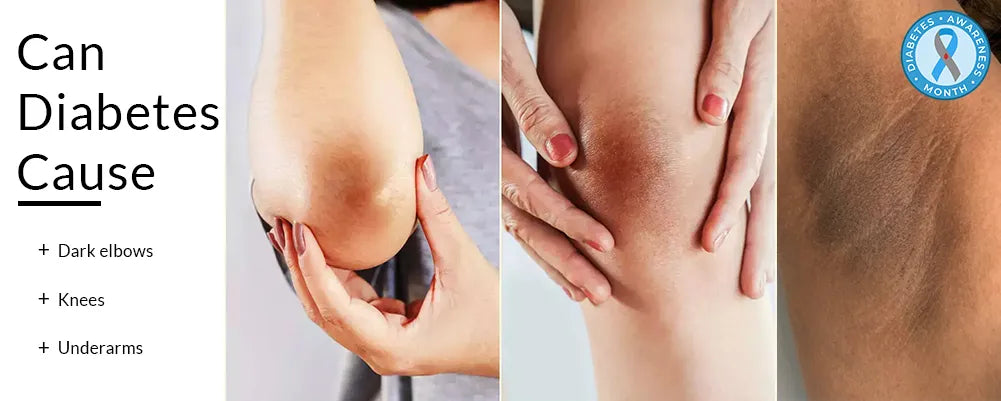Can diabetes cause dark elbows, knees, underarms?

Diabetes has a way of leaving its mark on various parts of the body. While we often hear about its impact on blood sugar levels, the shadow it casts on the skin is a less-explored territory. In this blog, we'll shine a light on the mysterious connection between diabetes and the darkening of elbows, knees, and underarms – an issue that goes beyond skin deep.
- Elbows, Knees, and Underarms: The Dark Corners of Diabetes:
Have you ever noticed dark patches on your elbows, knees, or underarms that seem to defy explanation? Welcome to the world of acanthosis nigricans, a tongue-twisting term for the darkening of the skin. IIn people with diabetes, certain areas often become darker, like the shadows of an untold story.

Insulin resistance plays a leading role in this dermatological drama. When the body becomes less responsive to insulin, the skin reacts by producing more pigment cells, resulting in the darkened appearance.
- Insulin Resistance: The Plot Twist:
When you have diabetes, your skin can get darker in some areas, and it's not just about how it looks. It's connected to a complicated dance happening inside your body between insulin and glucose.
When your body doesn't respond well to insulin (a condition called insulin resistance), it starts a series of events. To make up for the lack of response, your body produces more insulin. This extra insulin prompts your skin cells to multiply quickly, causing those mysterious dark patches, especially in places where your skin folds.

- The Unmasking of Acanthosis Nigricans:
Acanthosis nigricans is the actor stealing the spotlight in this skin drama. Beyond the elbows, knees, and underarms, it can also make a cameo on the neck, knuckles, and even the groin. While the darkening itself isn't harmful, it serves as a visual cue, signalling potential underlying health issues, particularly insulin resistance.
Hormonal fluctuations, obesity, and certain medications can join forces with insulin resistance, intensifying the darkening effect. However, not everyone with acanthosis nigricans has diabetes, making it essential to consult with a healthcare professional for a comprehensive evaluation.

- Facing the Darkness:
The good news is that the darkening of elbows, knees, and underarms is often reversible with effective diabetes management. Bringing the spotlight back to your skin involves a multi-faceted approach:
Blood Sugar Control: Keeping blood sugar levels within the target range is paramount. A well-managed diabetes regimen can help fade the shadows.
Weight Management: Since obesity is a contributing factor, maintaining a healthy weight through a balanced diet and regular exercise can make a significant difference.
Skincare Routine: While treating acanthosis nigricans involves addressing its root cause, incorporating a gentle skincare routine specially formulated for dark areas can help improve the appearance.

As you deal with the connection between diabetes and skin health, remember that understanding is the first step to taking care of yourself. Embrace the shadows, but let them be a part of your journey to overall health. It's not just about making your skin lighter; it's about finding the way to a healthier, more lively you.








